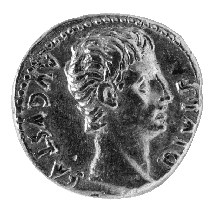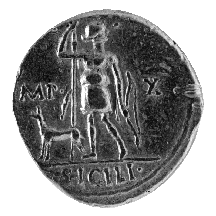



(67) Augustus - AV aureus, 15-13 B.C., 7.74 g. (inv. 91.108).
Obverse: Bare head of Augustus r.; AVGVSTVS DIVI F(ILIVS): Augustus, son
of a god (the Divine Julius Caesar).
Reverse: Diana standing l., wearing short tunic, leaning on spear in r.
and holding bow in l.;
dog standing to l.; [I]MP(ERATOR) - X: imperator for the tenth time;
in exergue,
SICILI: Sicily.
Provenance: Edward Gans, 1960.
Bibliography: C.H.V. Sutherland, The Roman Imperial Coinage I: from 31
BC to AD 69, rev. ed. (London 1984) 172; P. Zanker, The Power of
Images in the Age of Augustus (Ann Arbor 1988) 49-53.
Sextus Pompey, son of Pompey the Great, was a powerful naval commander who
waged a long struggle against Octavian, the heir of Julius Caesar destined
to become the emperor Augustus, in the years after Caesar's assassination.
Although Pompey styled himself a son of Neptune for his naval prowess, Octavian
regarded him as a pirate. His fleet, which was based in Sicily, had defeated
Octavian's forces on several occasions, but at Naulochus in 36 B.C. Octavian
prevailed. The Senate awarded him a lesser triumph (a solumn procession
into the city), an annual victory celebration, and a gilded statue, as well
as the right to wear the laurel wreath. Octavian, who by this time had begun
to associate himself with the god Apollo, attributed his victory over Sextus
Pompey to Apollo and his sister Diana; there was a sanctuary of Diana near
the site of the battle. During this battle he was said to have vowed a temple
to Apollo on the Palatine; he built it next to his own house, which further
solidified his identity with the god.
The mint at Lugdunum, modern Lyons, located near much of the western military
activity in the Augustan period, was the source of numerous issues with
military themes. This coin depicting Diana of Sicily on its reverse, issued
long after the battle, recalls the event which did much to establish the
power of Octavian in the West.
C.L.L.



All contents copyright (c) 1996.
Lawrence University
All rights reserved.